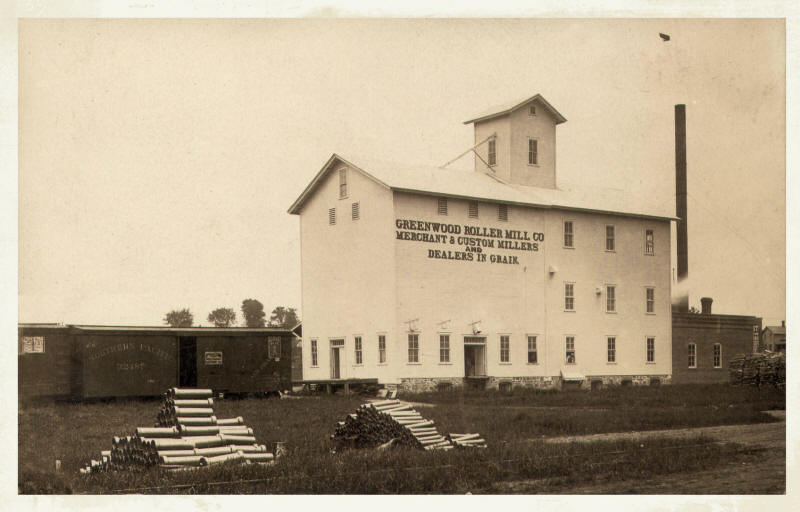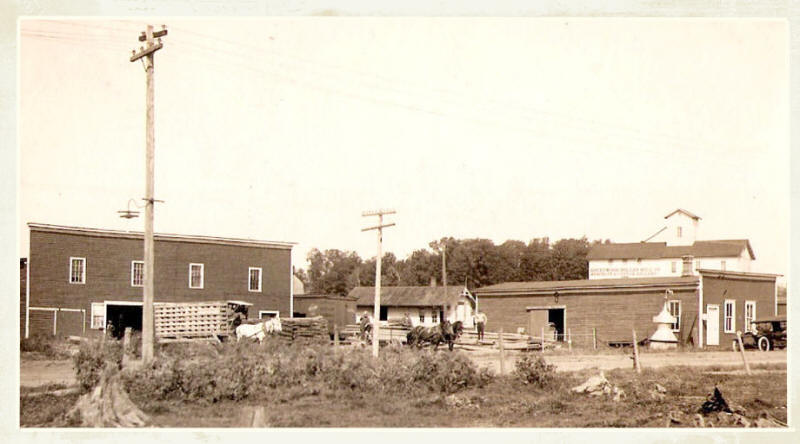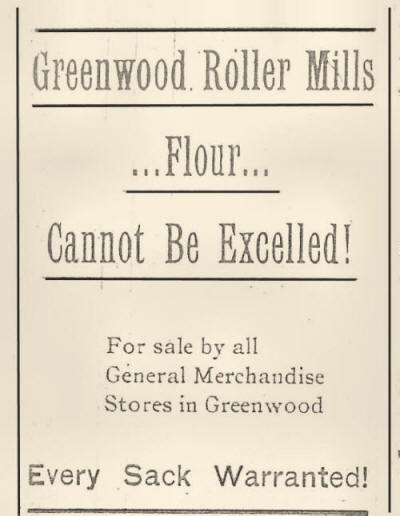History: Greenwood, Wis. Roller Mills
Contact: janet@wiclarkcountyhistory.org
Surnames: Foster, Shrimpton, Bailey, Palmer, Hartson, Bowen, Wollenberg
----Source: Greenwood Gleaner (Greenwood, Wis.) 1900 - 1903
Greenwood Roller Mills
Greenwood, Clark Co., Wisconsin
| ---STRAIGHT FLOUR, manufactured at our Greenwood mill from the best wheat only, every sack guaranteed. For sale at the Big Store. |
The above ads appeared in the Greenwood Gleaner, February 2, 1900.
Greenwood Gleaner Ad [July 23, 1903]
In the fall of 1899, Nathaniel C. Foster of Fairchild, the railroad magnet for whom Foster township was named, erected the "Greenwood Roller Mills" (pictured below). It opened for operation in the spring of 1900, with thirty year old Franklin W. Shrimpton as chief miller and operations manager. Frank learned the skills from his father, an immigrant from England, who was an experienced miller in De Kalb, Illinois. The Shrimptons were a hard working, well respected family. Frank married shortly after acquiring his position at the mill. Edward T. Bailey served as engineer. In 1902, when it was incorporated under the title of the Greenwood Roller Mill Co., with N.C. foster as President; G. A. Foster, Secretary and Treasurer, and F. W. Shrimpton, Business Manager.
In March of that same year, the newly wed twenty-three year old, Levi Palmer of Loyal, Wisconsin took a position with the company, but later that summer resigned. For a time in 1916, Henry Hobart Hartson, who twice owned and edited the Greenwood Gleaner, managed the Greenwood Roller Mills and became part owner. In 1918, Erastus Bowen was president and Edward F. Wollenberg was secretary and treasurer of the Mills. The company was listed in the 1926 business directory of the city.
This mill undoubtedly did a larger and more extensive business than any mill in the county, being extensive purchasers and shippers of all kinds of grain, besides making wheat, buckwheat, rye and graham flour, and also doing an enormous custom grinding business. It was equipped with five double roll stands and three pair of feed rolls, all of which were operated by a sixty-five horsepower steam engine, and was is in continuous operation the year around. The interior of the mill was usually clean and appealing to customers and visitors. The mill was widely known all over Clark County and its reputation became more widely known with each passing year. It eventually became a Stock Company Mill before the property was eventually sold.
Employees--If you can add to this list, please contact us.
1900--Edward T. Bailey (engineer)
1900-Frank W. Shrimpton
1900--Levi Palmer
1910-Walter Stabnow
1916--Henry Hobart Hartson
1918--Erastus Bowen
1918--Edward F. Wollenberg

Greenwood Roller Mill
Photo Courtesy of Tim Plunkett.
Panoramic View of Greenwood (1909)

Greenwood Roller Mills, 1926 ca.
Photo Courtesy of the Noah Family Collection.
Published Clips
Levi Palmer of Loyal began Monday as helper in the new flour and grist mill. Greenwood Gleaner 3-9-1900.
------------------------------------
Frank W. Shrimpton is taking a two weeks’ lay off for a visit with his
people in Salem, Neb. Greenwood Gleaner 5-4-1900.
-------------------------------------
Levi Palmer has resigned his position in the Greenwood Roller Mills, and in company with his father moved a few miles south of Stanley, where they have bought land and timer, purposing to run a saw mill. Greenwood Gleaner 8-24-1900.
-------------------------------------
Better Than Logs--The Greenwood Roller Mills Mean New
Impetur to Farming.
After delays in waiting for cuts we are able in this issue to give a short
description of the Greenwood Roller Mills, which has now been running over
three months. Without a doubt this is one of the best investments that has
ever been made in this city. Not that is will employ as many men or
represents as large an investment as some other industries, but because it
is a permanent institution that will help more than is easily realized to
develop the farming interests of the entire county. It insures a ready cash
market for those who will raise grain to sell. And those who raise grain for
their stock will always be sure of coming to Greenwood and being able to get
their grist ground.
The mill, elevator and engine room measures 36x110 ft. The mill and elevator
are combined under one roof, each measuring 36x40 ft. The whole is four
stories high with a cupola added. A basement extends under the entire
building. Running through the entire length of this is the main line
shafting which connects directly with the engine in the engine room. By
belting with this shafting power is furnished for all the machines in the
mill. Here are the 23 pair of elevator boots or bottoms of elevator shafts
whch carry the grain and products of the mill to the various places as
needed. A long conveyor with an auger like machine inside carries the grain
from the bins to the elevator spouts preparatory to grinding. Besides these
the basement contains a Western cornsheller, a Bison crusher for crushing
corn and the cob together for feed where desired. There are also four large
bins for receiving different grains from the farmers and one large one to
receive grain from the car before it is carried to the elevator.
Coming up to the first floor are the five double stand 7x18 Wolf roller
mills which do all the wheat grinding, the highest grades coming from the
fifth set of rolls. A Wolf feed roller, 9x18, three pair of rolls high, does
the feed grinding. An interesting machine in this room is the Imperial flour
packer, which packs and weighs the flour in 25, 49, 98, 140 and 196 lb.
sacks. The mill is supplied with three sets of scales, so that every
particle of grain coming in, or to be ground is weighed out and all
accounted for. In this room are the feed spouts, from which is drawn any
finished product of the mill, as wanted . Farmers' grists are received on
the north of the mill, where they are emptied through gates into bins on the
inside. The first floor of the elevator is used for a store room for flour
and feed. Here are levers which throw the grain from the bins above to any
part of the mill, thus saving much time and climbing of stairs.
On the secord floor are lines of shafting which connects with the machinery
above. Besides storage bins on this floor, there are two Wolf purifiers for
taking impurities out of wheat middlings; a Richmond brand and a shorts
duster for finishing brand and shorts. It takes an expert to get around in
this room so full of machinery, bins, etc., is it.There is not a foot of
room wasted. In fact this could be said of the entire mill. A fan in this
room draws the hot air from the rolls below, and discharges it into sets of
automatic tabular dust collectors. A cookie machine up toward the ceiling
cleans the wheat of that foreign element. A 60 bushel hopper scale weights
the wheat as it come from the bins before grinding.
One of the old centrifugal reels is also at work on this floor and is used
for finishing the lowest grade of flour. A shaker screen is also in this
room, used for cleaning oats and other grain for feed. Near by is a shaker
sieve for handling corn meal. There is also another set of tubular dust
collectors in this room.
In the fourth story is the line shafting to drive the elevators. All the
elevator heads, except three larger ones that run up into the cupola, are
here. In the cupola are, besides the elevator heads mentioned, two large
storage bins for feeding the grain to the cleaning machine. The fourth floor
leads into the elevator proper where are twenty bins holding 1,000 bushels
of grain each. In the top of this building is a turn table arrangement by
which grain is sent into any of the twenty bins from the car outside. This
can be done by the operator from down stairs by simply turning a lever, this
saving hundreds of steps, to say nothing of time.
The operators of the mill are F. W. Shrimpton, head miller: Levi Palmer,
assistant miller: E. T. Bailey, engineer. Speaking of the engineer we must
not forget to mention the domain where he holds sway. The engine room is
solid brick, 30x36 feet and one story high. This is divided by a brick wall,
the first room containing the large boilers which furnish the steam for the
engines and for heating purposes. In the second room is a 75 horse power
Westinghouse automatic engine, taking but little room, but powerful
nevertheless. A Worthington duplex steam pump pumps all the water used about
the premises. The electric lights for the entire building are furnish by a
Westingthouse dynamo.
The machinery for the mill was put in entirely by the Wolf Mfg. Co. of
Pennnsylvania, and is considered the best that money can buy. The firm is
noted for the quality of the machinery they put out. They have funrnished
some of the largest and best mills throughout the United States.
In this connection it will be of interst to our readers to know something of
the man who is back of this enterprise and who also is showing his faith in
Greenwood and vicinity by backing the Big Store.These are only beginnings,
for he has large plans yet to be developed, all of which will help to build
up the town and make it a more important trading point. While he is no man
to pose before the public, we are able , throught the kindness of the
Mississippi Lumbermen publishers, to give a likeness of N. C. Foster, and
also some facts regarding the man that are not generally known.
Not because he has been a leader among great lumbermen, but because he has
been a leader in this better way, N. C. Foster, of Fairchild, Wis., is noted
among men who have cut down forest. It was a quarter century ago that he
came to the little cutting in the woods of the southeastern corner of Eau
Claire county, called Fairchild and located to live and pursue the
profession lumbering which he had learned in his native town of Tioga, N. Y.
One of the first ventures of Mr. Foster in this little town was the erecton
of a hotel large enough to accommodate the ambitions of a much larger town.
The next year, 1876, he started a store and also built his first saw mill
which was burned five years later as was its successor after five years of
service. In 1887 the saw mill was erected which with amendments and
additions stands at the present day.
With a foresight long enough to see through the woods and into the clearings
beyond, Mr. Foster picked up timber lands tributary to his mill sufficient
to last it at the present speed to the year 1915. But this was not the end
of his vision. The land from which he cuts his timber is fit for farming.
Twenty years ago he built a grain elevator and began buying from farmers. A
flour and feed mill seemed a good adjunet to the elevator and that was
built.
The town had no good public hall, so Mr. Foster built a little opera house
to help things along.
These activities were not sufficient to engage Mr. Foster's surplus energy.
Directly west from Fairchild was a territory lying in the north of three
counties, quite undeveloped because of the remoteness from railway
privileges. He rolled up his sleeves and built a road through this section,
much to the joy of the settlers and to his own profit, for he sold it the
next year to the Northwestern line at a handsome advance. It has also proven
a good feeder to his mill. With the railroad money in his pocket he turned
and extended his logging road northeast far up into his Clark county timber.
This road now reaches Greenwood in Clark county, thirty miles away, and with
its branches is forty-five miles long. Greenwood being an uncommonly thrifty
town, it seemed good to Mr. Foster to establish there a flour mill during
the past year, and also a general merchandise store. The Fairchild general
store has developed into one of the largest and best equipped department
stores to be found outside the great cities. The Greenwood store is founded
on the same large plan.
Thus far this sketch has mentioned only N. C. Foster as the sole force
behond all these operations nor has his motive in diversifying his interests
and planning for a second generation of enterprises been named. The
explanation of this is found in a family of seven of whom Mr. Foster is the
father. It is only fair also to say that his three sons, now in the early
prime of life, are in a great measure to be credited with the success of Mr.
Foster's multiplied industries. These sons, Edward J., Gilbert A. and
Willard are member of the N. C. Foster Lumber Co., a corporation made up of
the family only, and owning all the interests mentioned, besides a line of
retail yards, farms and other odds and ends of valuable stuff. The conpany's
work is under three divisions, merchandise and milling, lumbering and
railroading. The first is in the immediate hands of Gilbert, the second is
in charge of Edward, the third, will probably be conducted by Willard, now
serving his apprenticeship, while the father, now 66 years of age, is active
commander-in-chief of the whole.
The country in which Mr. Foster has operated and in which he has planned
that his posterity shall continue to operate, has no cause for quarrel with
him. The wealth of the forests he has mown down has enriched the very ground
on which they stood: and so far as human eye can now see, will remain as a
permanent investment for an indefinite period.
Greenwood Gleaner, Friday, April 13, 1900
Memories
I enjoyed the picture and article of the Greenwood Roller Mills. It must have been built just when my Dad Don Warner was a baby. Always remember how there was a big mill stone down in the field sort of southwest of the Schofield House...no doubt Schofield farm land. As kids we explored all over the area & loved going to the Rips, etc., but that big millstone was fascinating. I wonder what happened to it. In the recent picture from down on the south end of Greenwood...noticed a big mill/factory type bldg. over near the Schofield house, & would guess the mill stone came from there? Norma Telford
Related Links
Bio: Palmer, Levi (9-Mar-1900)
Contributors
|
© Every submission is protected by the Digital Millennium Copyright Act of 1998.
Show your appreciation of this freely provided information by not copying it to any other site without our permission.
Become a Clark County History Buff
|
|
A site created and
maintained by the Clark County History Buffs
Webmasters: Leon Konieczny, Tanya Paschke, Janet & Stan Schwarze, James W. Sternitzky,
|

